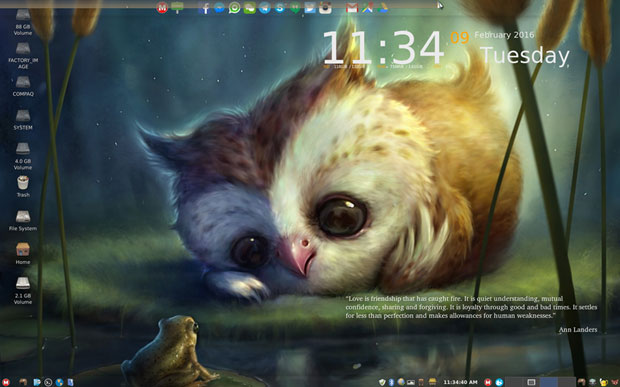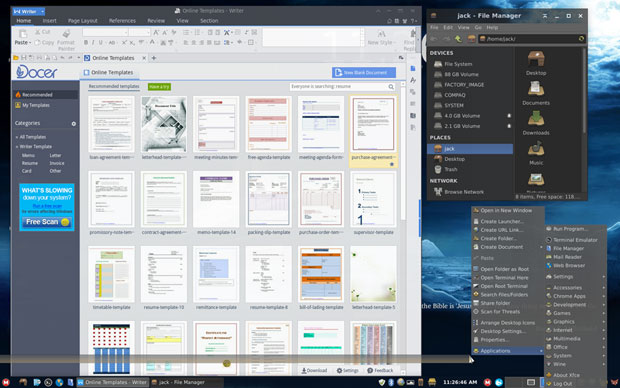
![]()
Makulu 10 Xfce edition continues developer Jacque Raymer’s track record of pushing the limits with useful and innovative features to keep his distro line a step ahead of the crowd.
He released Makulu 10 Xfce this week after more than 12 months in the making. The focus on this build is stability, speed and social integration. After spending several frustrating days chasing away glitches, I found that the Xfce edition can claim success with two of those three goals.
I consistently have had trouble with Makulu, regardless of the desktop flavor. Those issues continued with the latest release.
To be clear, I tested the release on three computers with a range of specs that exceeded the hardware recommendations for the Makulu 10 release. I had major performance issues in every attempt.
The installations proceeded without anomalies. The OS performed with recurring glitches. The system appeared to shut down properly.
Three Strikes, You’re Out
The major recurring problem is that on subsequent reboots, Makulu failed to boot. The system issued a diagnostic report that the X server suffered some internal error that disabled the MDM display manager.
I have used Makulu on various machines over the last few years. I constantly test Linux distros and other software. I routinely install most for testing and uninstall them when done. Few distros impress me enough to keep using them.
Not so with the Makulu line. I ran different versions of Makulu on various test computers. I alternated among Cinnamon, Aero, Unity, GNOME and Xfce flavors.
Eventually, each one fell out of favor. Not because I did not like using them. When they worked, the entire line was fun and inviting, but I was constantly addressing lockups and other hiccups.
From Bad to Worse
I had hoped the latest Xfce release would put all of that behind me. Alas, I spent several days gritting my teeth over glitches that made using that edition of Makulu not nice.
After several reinstallations and configuration adjustments, the problems finally seemed to have abated. They included corrupted package installations, browser lockups and video driver mayhem, despite a Makulu application that swapped and updated proprietary drivers.
The final blow came after working in the Makulu OS for uninterrupted hours. On several computers, I shut down the OS and powered off the computer. When I repowered the computer, Makulu failed to boot as explained above.
Makulu Highlights
I presume that the initial release code had an error somewhere that made its way into the ISO. No doubt the Makulu community will resolve the issue and make a replacement version available, so what follows is a review of the Makulu 10 Xfce performance between successful boot and shutdown during my testing days of working with it.
Makulu’s name is derived from the word for “big chief” in the Zulu language. In a Linux world of countless distros offering the same old retreads of desktop environments, Makulu has the potential for being just that among other leading Linux lines. Makulu’s novel tweaking of desktop designs makes the distro both appealing and innovative.
The Xfce desktop is one of the most classic lightweight desktops. Makulu pumps in just enough innovation and uniqueness to make Xfce seem more modern and entertaining. What Xfce lacks in animation, Makulu’s treatment makes up for with integrated features and appealing desktop functionality.
For example, it wraps into the Xfce desktop social app integration unmatched by other Linux distros. You can use applications such as WhatsApp, WeChat, Facebook, Twitter and Instagram on the fly. Forget about logging in to a website or installing a third-party app — just click a button and you are in social business.
Plus, the desktop view is simply gorgeous. The background images are eye-popping. The upper-right quadrant of the screen is adorned with a time, date and system info display that actually is useful. In the bottom-right quadrant is a changing readout of quotes by a wide range of historical personalities.
Lucious Layout
The eye-catching visuals on every background image are part of the fun of using the latest Xfce release from Makulu. The other parts come from the desktop design and the unusual collection of software.

I added the workspace switcher applet to the traditional bottom panel. The system positions it along the far right end of the panel. The panel constituents and some of the default software are different in this release compared with earlier versions.
The same icon is used to launch the Whisker menu at the far right end of the panel. The red and white M icon on the right side of the panel launches the Synapse search window. Also in the collection, on the right end of the panel among the expected system icons, is the launcher for Variety to navigate the background image display.
The left end shows icons for Show the desktop along with launchers for the Software Manager, Terminal Emulator, default Web browser and the Thunar File Manager.
The panel shows thumbnail labels of open windows in between the two notification areas. It looks like the panel bar is in two parts. The on-by-default 100 percent transparency setting gives the impression that the unfilled center portion of the panel is not there.
The left edge of the screen holds by default launchers for any mounted hard drive partition and attached storage devices. Push the mouse pointer into the top of the screen to pop down a second panel that functions like a launch dock for the integrated social media apps. These include Makulu Linux Live Chat, Facebook, Facebook Messenger, WhatsApp, WeChat, Telegram, Skype, Google Hangouts, Twitter, Instagram, Gmail, Google Maps and Google Drive.
Feature or Liability
The integrated functionality is a mixed bag. Each launcher you click either opens another instance of the Google Chrome browser or puts the social media app into another browser tab or overlapping window.
They create a dizzying collection of clutter on the screen. Use alt-tab keys to cycle among the open tabs and overlaying windows.
If you use the Google Chrome browser on multiple computers, this integrated social situation can cause an intrusion on devices that do not run Makulu Xfce. Makulu apparently installs each social media add-on into your Chrome extensions. They appear as enabled add-ons in each Google Chrome browser installation you have.
Software Savvy
MakuluLinux is built around an unusual set of software choices, some of which are not common to other Linux distros.
The Makulu line comes preinstalled with the WPS Office suite. You might know this product as Kingsoft Office from your mobile device apps. The Kingsoft Office suite bundles Kingsoft Writer, Kingsoft Spreadsheet and Kingsoft Presentation.
WPS is outside the normal package management system as it is proprietary, so you have to periodically update it through the Web browser to download the latest patch or version update and install it. WPS has great potential and a lot more functionality than AbiWord, which is the usual Xfce word processor.
This release uses the Google Chrome browser instead of the Chromium open source browser used in earlier versions. Makulu also preinstalls Wine to run Microsoft Windows programs and the two game platforms — PlayOnLinux and Steam. Makulu Linux also includes a Chrome apps section in the menu to package all of the related Google services.
A killer app that makes using Makulu Linux well worth the setup struggles if you have more than one computer is the Makulu-Constructor. This application lets you make a one-to-one clone of your current Makulu system in an ISO format. You can use the ISO file to create a virtual machine installation or a handy reinstall backup file, or to clone your current installation on other hard drives.
Bottom Line
Makulu Xfce 10 has both Debian and Ubuntu 14.04 features and software, making it a hybrid. It fully supports the Ubuntu PPA feature for adding repositories and uses the Debian software center along with some of Ubuntu software’s repositories. It also is based on the Linux kernel 4.2 and the latest Xfce 4.12 desktop environment.
I cannot recommend the current release. A Linux OS that is cantankerous and prone to the issues I experienced gives Linux on the desktop a bad rap.
Want to Suggest a Review?
Is there a Linux software application or distro you’d like to suggest for review? Something you love or would like to get to know?
Pleaseemail your ideas to me, and I’ll consider them for a future Linux Picks and Pans column.
And use the Talkback feature below to add your comments!























































